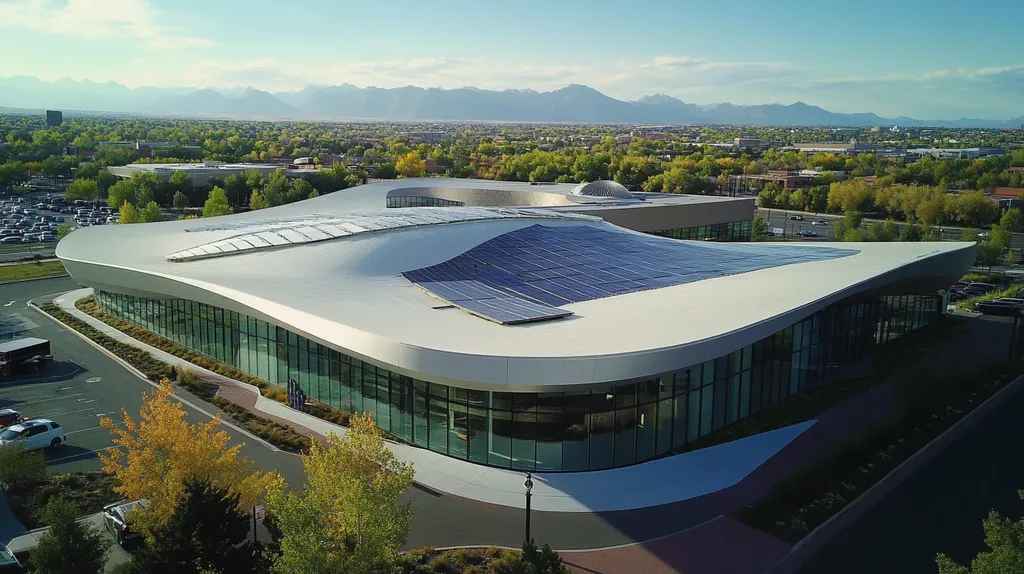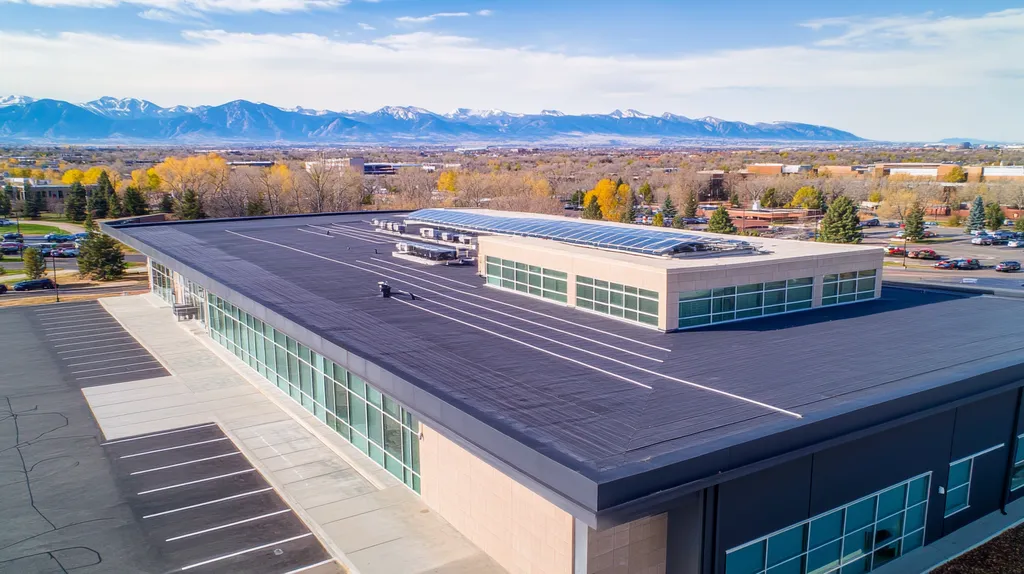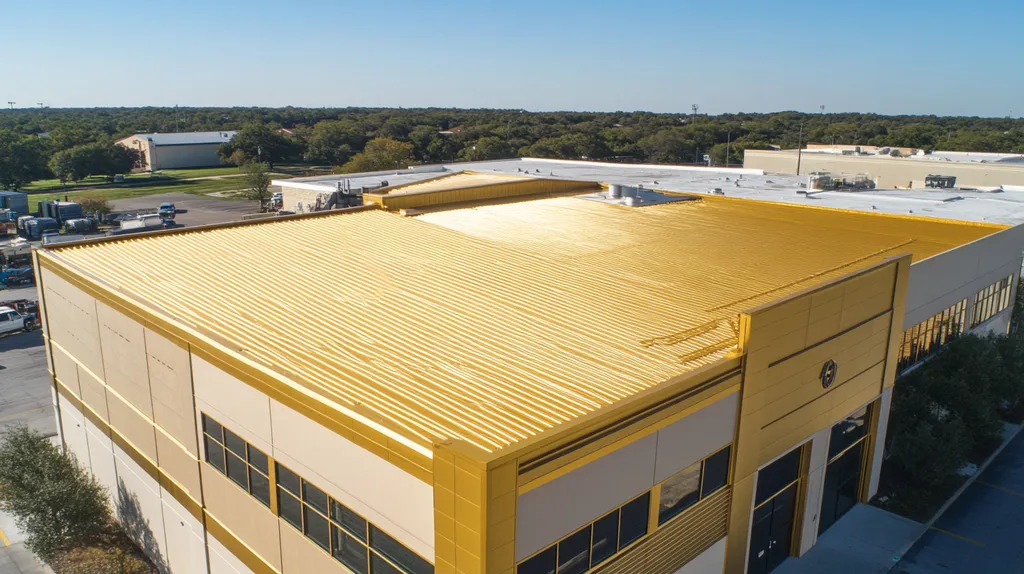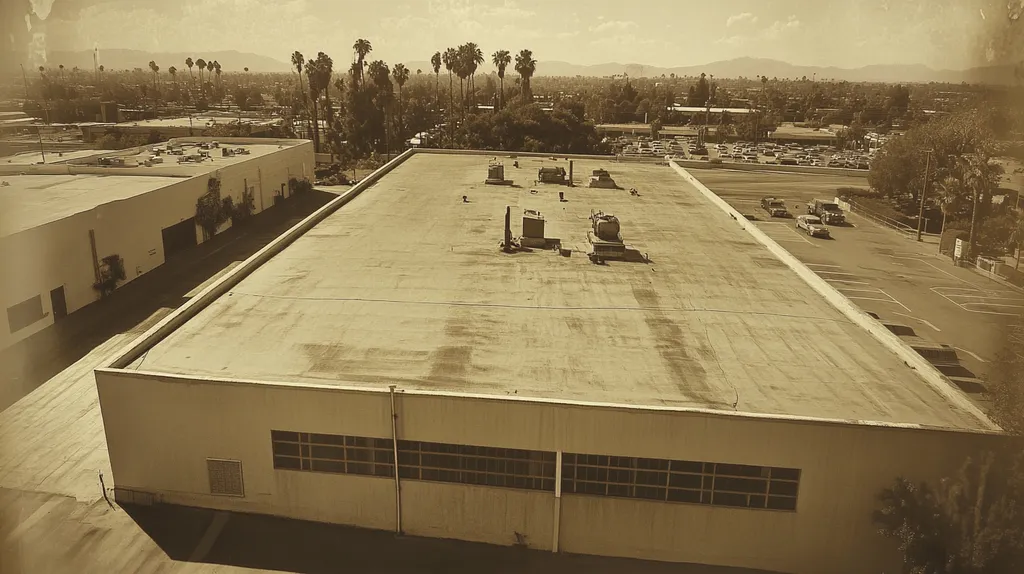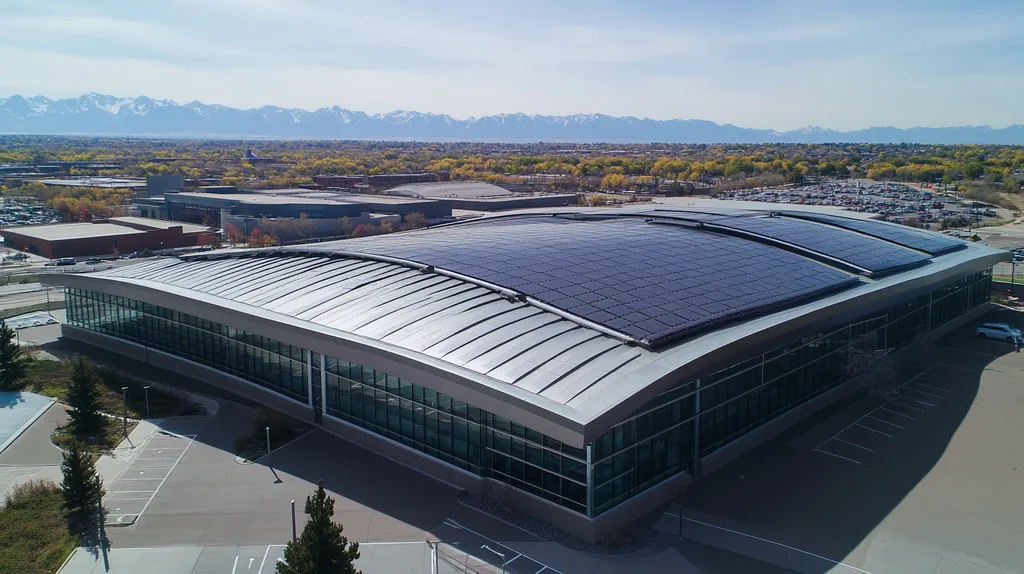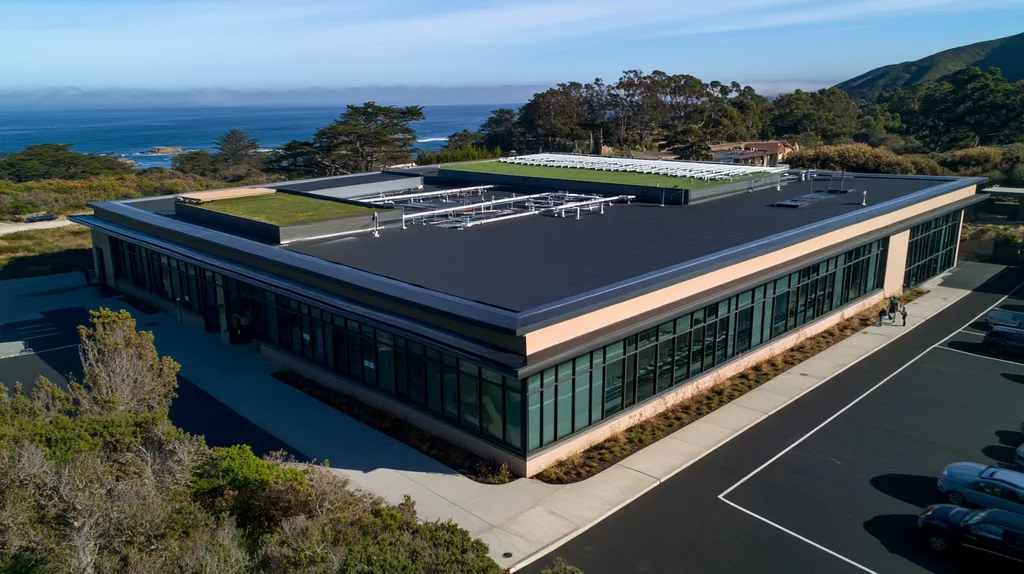In an era of extreme weather events and rising energy costs, commercial roof coatings have become critical infrastructure investments, with properly coated roofs showing up to 70% longer lifespans and 40% reduced cooling expenses.
Yet studies reveal that over 60% of commercial buildings lack optimal coating protection, leaving billions in assets vulnerable to premature deterioration and catastrophic leaks.
This comprehensive guide examines cutting-edge coating technologies, application methods, and maintenance strategies that transform commercial roofs from potential liabilities into high-performance assets.
SECTION 1: FUNDAMENTAL CONCEPTS
Commercial roofing faces an unprecedented challenge: protecting billions in business assets while managing escalating climate impacts and energy costs. Modern coating technologies offer a powerful solution, with properly coated roofs showing 25-40% reductions in cooling costs and up to double the service life. For facility managers and property owners, understanding coating fundamentals isn’t just about maintenance – it’s about protecting their bottom line while ensuring business continuity.
Principles of Roof Coating Technology
Modern roof coatings create seamless, waterproof membranes that actively protect underlying roofing materials from degradation. These systems work by combining multiple protective mechanisms, including UV reflection, moisture resistance, and thermal regulation.
The core function of coating technology lies in its ability to form an impermeable barrier while maintaining flexibility. This dual capability ensures protection against water infiltration while accommodating natural building movement and thermal expansion.
Advanced coating formulations now incorporate nano-materials and smart polymers that enhance durability and self-healing properties. These innovations allow coatings to maintain their protective qualities even after years of environmental exposure.
The effectiveness of coating systems depends heavily on proper surface preparation and application techniques. Even the most advanced coating will fail without correct substrate preparation and environmental conditions during application.
Types and Chemistry of Commercial Coatings
Modern urethane coatings demonstrate exceptional durability with tensile strengths reaching 1,000 psi and elongation capabilities of 375%, ensuring superior protection against environmental stresses. (source: Neogard)
Silicone coatings excel in extreme temperature environments, maintaining flexibility from -80°F to 350°F. Their molecular structure creates exceptional water resistance, making them ideal for areas prone to ponding water.
Acrylic coatings provide excellent UV resistance and solar reflectivity, typically achieving solar reflectance values above 80%. Their water-based formulation makes them environmentally friendly and easy to apply.
Polyurea systems offer rapid curing times and exceptional chemical resistance. These coatings can be walked on within hours of application, minimizing facility disruption during installation.
Environmental and Climatic Impact on Coatings
Geographic location significantly influences coating performance and selection. Coastal areas require enhanced salt-spray resistance, while urban environments need increased chemical resistance against acid rain and pollutants.
Temperature fluctuations create thermal stress that can compromise coating integrity. Modern formulations account for these challenges through advanced polymer technology that maintains flexibility across wide temperature ranges.
UV exposure remains a primary degradation factor, particularly in high-altitude or equatorial regions. Latest coating technologies incorporate specialized UV absorbers and reflective pigments to combat this challenge.
Climate change has intensified weather patterns, requiring coatings to withstand more frequent extreme events. This has driven the development of hybrid systems that combine the best properties of multiple coating types.
SECTION 2: SYSTEM COMPONENTS
Modern commercial roofing demands an integrated approach where every component works in harmony. When even one element fails, it can compromise the entire system, leading to costly repairs averaging $15,000-25,000 per incident. Understanding and properly implementing system components isn’t just about preventing leaks—it’s about protecting valuable assets and maintaining business operations.
Key Materials and Substrate Compatibility
Materials used in commercial roof coating systems must meet strict performance standards while complying with Federal, State and local VOC regulations. Modern coating technologies combine environmental compliance with exceptional durability, creating systems that protect both facilities and the environment. (source: Neogard)
Substrate evaluation forms the foundation of successful coating applications. Different roof surfaces—whether metal, concrete, or membrane—require specific coating formulations to ensure proper adhesion and performance.
Surface preparation protocols vary by substrate type. Metal roofs need rust inhibition and proper primers, while single-ply membranes require specialized cleaning and bonding agents.
Weather conditions during application significantly impact coating performance. Temperature, humidity, and dew point must align with manufacturer specifications to achieve optimal results.
Coating Layers and Thickness Specifications
Professional coating systems typically employ multiple layers, each serving a distinct purpose. The base coat provides adhesion and initial waterproofing, while subsequent layers enhance protection and durability.
Layer thickness must be carefully controlled to ensure proper curing and performance. Too thin, and the coating won’t provide adequate protection; too thick, and it may not cure properly or could develop surface defects.
Strategic reinforcement at high-stress areas like seams, flashings, and penetrations requires additional attention. These zones often need supplemental coating layers or specialized materials.
Regular thickness measurements during application ensure consistent coverage. Modern electronic gauges provide instant feedback, allowing real-time adjustments to maintain specifications.
Ancillary Products: Primers, Sealants, and Reinforcements
Primers serve as the critical link between substrate and coating system. They enhance adhesion, seal porous surfaces, and provide additional protection against corrosion or chemical attack.
High-performance sealants address dynamic joints and penetrations. Modern formulations maintain flexibility while resisting UV degradation and moisture infiltration.
Reinforcement materials strengthen vulnerable areas and provide additional puncture resistance. Fabric mesh, polyester mats, and specialized tapes create an integrated system that resists mechanical stress.
Detail work around roof penetrations requires specialized products. Pre-formed boots, corner pieces, and reinforcement patches ensure watertight seals at these critical points.
System compatibility between all components is essential. Using mismatched products, even if individually high-quality, can lead to premature failure and reduced performance.
SECTION 3: IMPLEMENTATION METHODS
Proper coating implementation represents the critical difference between a roof that lasts decades and one that fails prematurely. Industry data shows that 85% of early coating failures stem from improper implementation, not product defects. For facility managers, mastering these methods isn’t just about following procedures—it’s about protecting their building investment and avoiding the $50,000+ average cost of premature roof replacement.
Surface Preparation and Cleaning Techniques
Surface preparation stands as the foundation of coating success, with proper cleaning accounting for 70% of long-term performance. A methodically cleaned surface ensures maximum coating adhesion and durability.
Professional preparation begins with a comprehensive inspection to identify areas requiring special attention. This includes examining seams, penetrations, and existing damage that could compromise coating performance.
Power washing at 2,500-3,500 PSI removes surface contaminants while preserving substrate integrity. For stubborn deposits, specialized cleaning solutions break down oils and biological growth without damaging the roof surface.
The final preparation phase requires complete surface drying and verification of cleanliness through adhesion testing. This step prevents moisture entrapment that could lead to coating failure.
Application Procedures: Spraying, Rolling, and Brushing
Each application method serves specific purposes in the coating process. Airless spraying covers large areas efficiently, typically achieving application rates of 4,000-6,000 square feet per hour.
Rolling provides excellent control for medium-sized areas and ensures consistent millage. This method excels in situations where overspray must be strictly controlled or when working near sensitive equipment.
Brush application delivers precision for detail work around penetrations, corners, and edges. While time-intensive, this method ensures complete coverage in hard-to-reach areas.
Reflective roof coatings require particular attention to uniform application thickness to maximize their energy-saving potential. (source: Metacrylics)
Curing Times and Environmental Considerations
Environmental conditions directly impact coating performance and must be monitored throughout the application process. Temperature should typically remain between 50-90°F for optimal curing.
Relative humidity affects both application and curing phases. Levels above 85% can prevent proper coating formation, while levels below 20% may cause premature drying.
Wind speeds exceeding 15 mph interfere with proper application and increase overspray risk. Project scheduling should account for these factors to ensure optimal results.
Most coating systems require 24-72 hours for initial cure and up to 30 days for full cure. During this period, roof traffic must be strictly controlled to prevent damage to the developing coating membrane.
SECTION 4: MAINTENANCE REQUIREMENTS
In commercial roofing, maintenance isn’t just about preventing leaks—it’s about protecting substantial business investments. Studies show that neglected roof coatings can deteriorate 70% faster than properly maintained ones, leading to premature system failure. With replacement costs averaging $12-15 per square foot, proactive maintenance becomes essential for preserving both the coating’s protective qualities and the facility’s operational budget.
Routine Inspection and Condition Assessment
Successful coating maintenance begins with systematic inspections that identify issues before they escalate into major problems. Professional evaluations should occur bi-annually, with additional inspections following severe weather events.
Modern inspection protocols incorporate digital imaging and moisture detection technologies to create detailed condition maps. These tools help facility managers track coating degradation patterns and optimize maintenance schedules.
Documentation proves critical for warranty compliance and maintenance planning. Detailed records should include photos, measurement data, and repair recommendations to build a comprehensive maintenance history.
Early detection through regular inspections can extend coating life by 5-7 years while reducing repair costs by up to 60%. This proactive approach helps facilities maintain optimal protection and energy efficiency.
Repair and Recoating Protocols
The GacoFlex Polyurethane Roof Coating System demonstrates how proper maintenance can renew existing weathered surfaces while improving reflectivity, provided the underlying structure remains sound. (source: Gaco)
Small repairs require immediate attention to prevent expansion of damaged areas. Patch repairs should use materials compatible with existing coatings to ensure proper adhesion and performance.
Recoating decisions depend on coating type, wear patterns, and environmental exposure. Timing varies from 5-10 years based on these factors and the quality of ongoing maintenance.
Surface preparation remains crucial for repair success. Thorough cleaning and proper substrate conditioning ensure strong bonds between existing and new coating materials.
Managing Coating Degradation and Weathering Effects
Environmental stressors continuously challenge coating performance through UV exposure, thermal cycling, and moisture penetration. Understanding these degradation mechanisms helps facilities develop targeted maintenance strategies.
Regular cleaning prevents debris accumulation that can trap moisture and accelerate coating breakdown. Scheduled cleaning should address both visible contamination and microscopic pollutants that affect coating performance.
Climate-specific maintenance adjustments optimize coating longevity. Coastal facilities need more frequent salt removal, while urban locations require additional attention to chemical contaminants.
Monitoring coating thickness and reflectivity provides early warning of degradation. These measurements help facilities schedule maintenance before protective properties become compromised.
SECTION 5: PERFORMANCE METRICS
Commercial roofing performance metrics have become critical as facilities face mounting pressure to reduce energy costs while extending roof lifespans. Studies show that properly specified and monitored coating systems can reduce cooling costs by up to 30% and double roof service life. However, these benefits only materialize when coating performance is rigorously measured and maintained against established industry standards.
Measuring Reflectivity and Thermal Emissivity
Solar reflectivity and thermal emissivity directly impact building energy efficiency and coating longevity. Modern measurement tools can precisely track these metrics, allowing facilities to optimize their coating selections for maximum return on investment.
Initial solar reflectance values above 0.85 indicate excellent coating performance, but this number typically decreases 10-15% within the first three years. Regular testing helps identify when recoating becomes necessary to maintain energy benefits.
Thermal emissivity measurements reveal how effectively coatings release absorbed heat. Higher emissivity ratings, ideally above 0.85, contribute to cooler roof temperatures and reduced thermal stress on the coating system.
Digital infrared mapping now enables facilities to identify areas of decreased performance before visible degradation occurs. This technology helps target maintenance efforts and validate coating effectiveness across the entire roof surface.
Waterproofing Effectiveness and Leak Prevention
Silicone coatings demonstrate superior weather resistance and waterproofing capabilities compared to traditional materials, making them increasingly popular for commercial applications. Their molecular structure provides exceptional protection against ponding water while maintaining flexibility in extreme conditions. (source: KARNAK Corp.)
Modern testing protocols measure coating adhesion strength, elongation capabilities, and resistance to hydrostatic pressure. These metrics help predict real-world performance under challenging conditions.
Water absorption rates below 0.1% indicate excellent waterproofing performance. Regular testing of this metric helps identify early signs of coating degradation before leaks develop.
Adhesion testing at seams and penetrations verifies the coating’s ability to maintain watertight integrity at these critical points. Pull-test values above 2.0 N/mm² suggest optimal performance.
Longevity and Durability Testing Standards
Accelerated weathering tests simulate decades of environmental exposure in controlled laboratory conditions. These tests measure UV resistance, chemical stability, and mechanical properties over time.
Impact resistance testing ensures coatings can withstand typical roof traffic and maintenance activities. Standards require coatings to resist puncture from specific weights dropped from standardized heights.
Tensile strength measurements evaluate a coating’s ability to resist tearing and splitting. High-performance coatings maintain at least 200 psi tensile strength after weathering exposure.
Elongation capabilities indicate how well coatings accommodate building movement and thermal expansion. Quality systems maintain minimum 100% elongation throughout their service life to prevent cracking and separation.
SECTION 6: OPTIMIZATION STRATEGIES
Today’s commercial roofing challenges demand sophisticated optimization strategies as facilities face unprecedented weather extremes and rising energy costs. Studies show that strategic coating choices can extend roof life by 15-20 years while reducing cooling costs by up to 40%. However, without proper optimization, even premium coating systems may deliver only a fraction of their potential benefits, leaving facilities vulnerable to premature degradation and escalating operational costs.
Selecting Coatings Based on Roof Type and Exposure
Coating selection must align precisely with both substrate characteristics and environmental demands. Each roofing system presents unique chemical and physical properties that require specific coating compatibility to achieve optimal performance.
Metal roofs demand corrosion-resistant formulations with superior adhesion and flexibility to accommodate thermal movement. Single-ply membranes require coatings that won’t degrade the underlying material while providing enhanced UV protection.
Mule-Hide’s 100% silicone coating system demonstrates how specialized formulations can deliver superior protection across diverse substrates, offering exceptional weathering resistance and durability that meets ASTM D6694 standards. (source: Mule-Hide)
Regional climate considerations significantly impact coating performance. Coastal environments require enhanced salt resistance, while urban settings demand formulations that resist chemical pollutants and acid rain.
Enhancing Energy Efficiency Through Reflective Coatings
Modern reflective coatings serve as a building’s first line of defense against solar heat gain. These systems can reduce roof surface temperatures by up to 50°F, directly impacting HVAC loads and energy consumption.
Performance metrics for reflective coatings focus on both initial and aged solar reflectance. Premium systems maintain reflectivity above 80% even after three years of exposure, ensuring sustained energy benefits.
Application thickness plays a crucial role in reflective performance. Proper millage ensures optimal coverage and maintains reflective properties throughout the coating’s service life.
Strategic placement of highly reflective coatings near HVAC units and other heat-sensitive equipment maximizes their impact on building energy efficiency.
Integrating Sustainability and Cost-Benefit Analysis
Sustainable coating strategies must balance environmental impact with long-term financial returns. Modern systems can reduce waste through longer service life while supporting green building initiatives.
Life-cycle cost analysis reveals that premium coating systems typically deliver ROI within 3-5 years through reduced energy costs and maintenance requirements. These savings compound over time, especially in regions with high cooling demands.
Environmental benefits extend beyond energy savings. Low-VOC formulations improve air quality during application, while reduced roof temperatures help combat urban heat island effects.
Integration with building management systems allows real-time monitoring of coating performance. This data-driven approach enables proactive maintenance and optimization of energy-saving benefits.
Looking Ahead
With commercial roofs representing up to 40% of building energy losses and maintenance costs, proper coating selection and implementation has never been more critical for facility management.
Modern coating technologies now offer unprecedented protection, with documented lifespans exceeding 20 years and energy savings of 25-40% when properly specified and maintained.
Yet the industry stands at a crossroads, as climate change and rising energy costs demand even more from commercial roofing systems.
The future belongs to facilities that embrace comprehensive coating strategies, combining advanced materials with rigorous implementation and maintenance protocols.
Those who invest in optimal coating solutions today position themselves to reduce long-term costs while ensuring superior protection for their valuable assets tomorrow.
FREQUENTLY ASKED QUESTIONS
Q. What makes coatings vital for commercial roof durability?
A. Coatings significantly reduce cooling costs and extend service life by creating a protective barrier. They help maintain optimal temperatures and reduce the risk of water infiltration, ultimately delivering great savings and reliability for business owners.
Q. How do I choose the right coating for my industrial roof?
A. Selecting the right coating depends on the roof substrate and environmental factors. Evaluate specific needs, such as exposure to moisture or UV rays, to determine the best coating type, ensuring compatibility for optimal performance.
Q. What preparation steps are necessary before applying coatings?
A. Proper surface cleaning is critical, requiring thorough inspections and power washing to remove contaminants. Ensuring the surface is completely dry before application is also essential to achieve maximum adhesion and performance of the coatings.
Q. How can I ensure my commercial roof coatings last longer?
A. Regular maintenance, including biannual inspections and timely repairs, is vital for longevity. Proactively addressing small issues can prevent larger problems and help the coatings maintain their protective properties over time.
Q. What performance metrics should I track for my commercial roof?
A. Important metrics include solar reflectivity, thermal emissivity, and waterproofing effectiveness. Monitoring these will help you evaluate the roofing system’s performance, ensuring it meets efficiency and longevity standards.
Q. How can I optimize the energy efficiency of my industrial roof?
A. Utilizing highly reflective coatings can significantly lower roof temperatures and reduce energy costs. Careful application planning ensures proper thickness, enhancing efficiency by maximizing cooling benefits and minimizing HVAC loads.
Q. What common mistakes should I avoid when applying coatings?
A. Key mistakes include improper surface preparation and not adhering to environmental conditions during application. Skipping these steps can lead to coating failure and may void warranties, leading to costly repairs.

